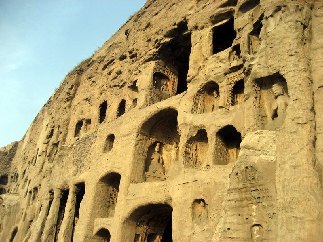Yungang Grottoes, located in Datong City of Shanxi province, represents outstanding Chinese Buddhist Grottoes Art during the 5th and 6th century with 51,000 Buddhist statues in 252 grottoes. Among them Tanzhao Five Grottoes is a typical masterpiece at the first peak of Chinese Buddhist art for its compact and uniform layout.

Construction of the grottoes first began on the second year (453) of the Xing'an reign of the Northern Wei Dynasty (386-534), and most of them were completed before 494 when the capital of North Wei Dynasty was moved to Luoyang City. The work on statuary sculpture did not end until the Zhengguang reign (520-525). The Grottoes were built on the walls of mountains, and stretch for about one kilometer from east to west. At present there are 45 grottoes, 252 big and small niches, and 510,000 stone statues, of which the biggest is 17 meters high and the smallest is only a few centimeters high. Inside the grottoes Buddhas of Bodhisattva, Hercules, Flying Apsaras were carved vividly on the pillar in an elegant way. Inheriting the essence of realistic art of the Qin and Han dynasties (221BC-220AD), the grottoes set a precedent for Romanism in grotto building in the Sui and Tang dynasties (581-907) that followed. Yungang Grottoes was one of the world famous Stone Buddha treasures in the world, and also one of the Three Great Chinese Grottoes along with Mogao Grottoes in Dunhuan City of Gansu Province and Longmen Grottoes in Henan Province.
